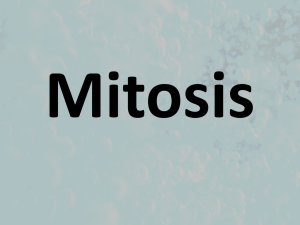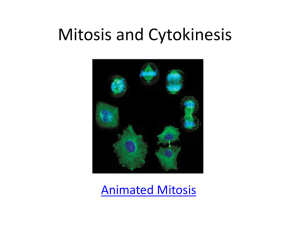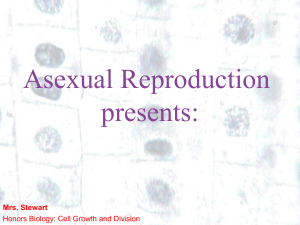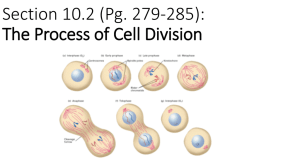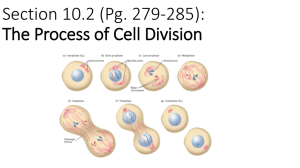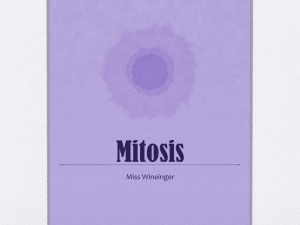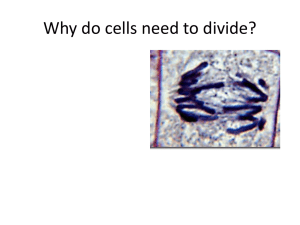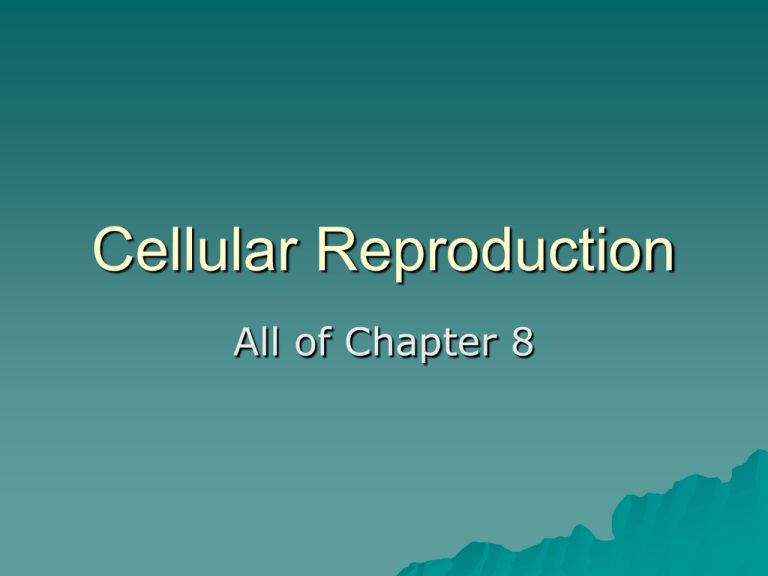
Cellular Reproduction
All of Chapter 8
Recall that…
nucleotide – a monomer of DNA or RNA
consists of nitrogen base, a sugar, and a
phosphate group
DNA or deoxyribonucleic acid – a
double helix nucleic acid – hereditary
information
RNA or ribonucleic acid – nucleic acid
consisting of single strand with ribose and
uracil unlike DNA
Nucleic acid – organic molecule that
stores & carries important info for cell
function
Cell Division:
All
cells are derived from preexisting
cells (Cell Theory)
Cell division - process where cells
produce new cells
Cell
division differs in prokaryotes
(bacteria) & eukaryotes (protists,
fungi, plants, & animals)
Some tissues must be repaired often
i.e. lining of gut, white blood cells,
skin cells w/a short lifespan
Other cells do not divide at all after
birth i.e. muscle & nerve
Reasons for Cell Division:
Cell
growth
Repair & replacement of
damaged cell parts
Reproduction of/ species
Copying DNA:
each
new cell must get a complete
set of the DNA molecules b/c
instructions are in DNA
DNA must be copied (replicated,
duplicated) before cell division
Chromosomes & Their Structure:
The
plans for making cells are coded
in DNA
DNA, deoxyribose nucleic acid, a
long thin molecule that stores
genetic info
DNA in human cell consists of ~ six
billion pairs of nucleotides
DNA is organized into giant
molecules called chromosomes
Chromosomes are made of protein &
a long, single, tightly-coiled DNA
molecule visible only when the cell
divides
http://highered.mcgraw-hill.com/olc/dl/120073/bio14.swf
mitosis
When
a cell is not dividing DNA is
less visible & is called chromatin
DNA in eukaryotic cells wraps tightly
around proteins called histones to
help pack the DNA during cell
division
Nonhistone proteins help control
the activity of specific DNA genes
Kinetochore proteins bind to
centromere and attach chromosome to
the spindle in mitosis
Centromeres hold duplicated
chromosomes together before they
separate in mitosis
Telomeres are the ends of chromosomes
which are important in cell aging
When DNA makes copies of itself before
cell division, each half of the chromosome
is called a sister chromatid
DNA of prokaryotes (bacteria) is one,
circular chromosome attached to/
inside of/cell membrane
Chromosome Numbers:
Human
body cells have 23 pairs of
chromosomes or 46 chromosomes
(diploid or 2n number- cells that
have 2 sets of chromosomes)
The 2 chromatids of a chromosome
pair are called homologues (have
genes for the same trait at the same
location)
Homolog
Human body cells are somatic cells undergo
mitosis. Human reproductive cells or gametes
(sperms & eggs) have one set or 23 chromosomes
(haploid or n number)
Organism
Chromosome
Number (2n)
Human
46
Fruit fly
8
Lettuce
14
Goldfish
94
Fertilization,
joining o/egg & sperm,
restores diploid chromosome number
in/zygote (fertilized egg cell)
Sex chromosomes, either X or Y,
determine the sex o/organism
XX = female
XY = male
autosomes
– all other chromosomes,
except X & Y
Karyotype – a photomicrograph of
chromosomes from a dividing cell
arranged in pairs by size, long to short,
ending w/sex chromosomes
A human karyotype has 22 pairs of
autosomes and 1 pair of sex
chromosomes (23 total)
What sex
is this
organism?
Genes:
gene
- section of DNA which codes
for a protein
Each gene codes for ONE protein
Humans have ~ 50,000 genes or
2000/ chromosome
About 95% o/DNA in chromosome is
"junk" that does not code for any
proteins
References
http://sps.k12.ar.us/massengale/cell_division_notes.htm
Cell Division
8.2
Cell Cycle:
Cells
go thru phases or a cell cycle
during their life before they divide to
form new cells
The cell cycle includes 2 main parts -- interphase, and cell division
Cell
division includes
– mitosis (nuclear division)
– cytokinesis (division of the cytoplasm)
Interphase
– "resting stage"
longest part of a cell's life cycle
– cell isn't dividing
– Cells grow, develop, & carry on all their
normal metabolic functions
– 3 parts --- G1, S, & G2 phases
Interphase:
G1
or 1st Growth Phase occurs
after a cell division
– Cells mature & inc in size by making
more cytoplasm & organelles while
carrying normal metabolic activities
S
or Synthesis Phase
follows G1 and the genetic material
of the cell (DNA) is copied or
replicated
Interphase cont’:
S
or Synthesis Phase follows G1
– genetic material of the cell (DNA) is
copied or replicated
G2 or 2nd Growth Phase
- occurs after S Phase
- cell makes all structures needed to
divide
Cell division in Prokaryotes:
Prokaryotes
i.e.bacteria
don’t have a nucleus
Binary fission –
process of dividing into 2
identical new cells
- asexual method of
reproduction
Binary fission cont’
chromosome
(attached
to cell membrane)
makes a copy of itself
and cell grows to 2X
normal size
Next, a cell wall forms
btw/chromosomes &
parent cell splits into 2
new identical daughter
cells (clones)
Cell Division in Eukaryotes:
Eukaryotes have a nucleus & membranebound organelles which must be copied
exactly so the 2 new cells formed from
division will be exactly alike
original parent cell & 2 new daughter cells
must have identical chromosomes
DNA is copied in the S phase o/cell cycle &
organelles, found in the cytoplasm, are
copied in the Growth phases
Both the nucleus (mitosis) and the
cytoplasm (cytokinesis) must be divided
during cell division in eukaryotes
Stages of Mitosis:
Mitosis
- Division o/nucleus occurs 1st
–asexual method of reproduction
–4 stages
Prophase
Metaphase
Anaphase
Telophase
Prophase:
Chromosomes become visible when they
condense into sister chromatids
Sister chromatids attach to each other by
the centromere
Centrioles in animal cells move to opposite
ends of cell
Spindle forms from centriole (animals) or
microtubules (plants)
Kinetochore fibers of spindle attach to
centromere
Polar fibers of spindle extend across cell
from pole to pole
Nuclear membrane dissolves
Nucleolus disintegrates
Metaphase:
Chromosomes
line up in center or
equator of the cell attached to
kinetochore fibers of the spindle
Anaphase:
Kinetochore
fibers attached to the
centromere pull the sister chromatids
apart
Chromosomes move toward opposite
ends of cell
Telophase:
Nuclear
membrane forms at ea end
o/cell around the chromosomes
Nucleolus reforms
Chromosomes become less tightly
coiled & appear as chromatin again
Cytokinesis begins
Cytokinesis:
Cytoplasm
of the cell
and its organelles
separate into 2 new
daughter cells
In animals, a groove
called the cleavage
furrow forms
pinching the parent
cell in two
Cytokinesis cont’
In plants, cell plate forms down the middle
o/cell where the new cell wall will be
Summary of Mitosis:
Interphase Cell
matures &
carries on
normal activities
DNA copied &
appears as
chromatin
Nucleolus visible
Early Prophase
Chromosomes
condense &
become visible
Centrioles
separate & spindle
starts forming
Late Prophase
Spindle forms with
aster at each pole
Nuclear membrane
& nucleolus
disintegrate
Centromere of
chromosomes
attaches to spindle
fibers
Metaphase
Chromosomes
line up at the
equator of the
cell attached to
kinetochore
fibers of spindle
Anaphase
Centromeres
split apart
Homologs move
to opposite poles
of the cell
Telophase/Cytokinesis
Nuclear membrane & nucleolus
reform
Cell pinches into 2 cells in animals
In plants, a cell plate separates the 2
new cells
Cancer
is Uncontrolled Mitosis:
Mitosis must be controlled, otherwise
growth will occur w/out limit (cancer)
Control is by special proteins
produced by oncogenes
Mutations in control of proteins can
cause cancer
Meiosis
8.3
Similar
Several
to mitosis- nuclear division
differences
– Involves 2 cell divisions
- Results in 4 cells with 1/2 the normal
chromosome number for DNA.
Meiosis & Sexual Reproduction
Reduces
the number of chromosomes
in new cells by half o/ original cell
New cells have a single copy of
chromosomes (23 total) but are not
identical to each other or parent cell
Used for making gametes ( sperm and
eggs) w/haploid or n number
Recall Vocabulary:
– Diploid (2N) - Normal amount of genetic material
– Haploid (N) - 1/2 the genetic material.
In Meiosis
cells divide twice after single DNA duplication
Produces 4 haploid cells or gametes
MEIOSIS I
MEIOSIS II
separates homologs
separates sister chromatids
Crossing over
No crossing over
Half # of chromosomes 23 Same # chromosomes 46
Stages:
Prophase I
Metaphase I
Anaphase I
Telophase I
Stages:
Prophase II
Metaphase II
Anaphase II
Telophase II
When sperm fertilizes an egg to form
zygote, the diploid number of
chromosomes is restored
(23 + 23 = 46)
Egg cells or ova (ovum, singular) are
larger, nonmotile cells
Oogenesis - meiosis producing eggs
occurs in female's ovaries
Oogenesis
Sperms
contain less cytoplasm
– smaller
– flagellum to swim to the egg
Spermatogenesis
meiosis
producing sperm cells &
occurs in the testes
Spermatogenesis
Meiosis I:
The
cell that undergoes Meiosis I is a
primary spermatocyte or oocyte
Remember –cyte or -cyto means
cell/hollow container
Diagram showing the
reduction in number of
the chromosomes in
the process of
maturation of the
ovum.
Oocyte: A female
germ cell in the
process of
development. The
oocyte is produced in
the ovary by an
ancestral cell called an
oogonium and gives
rise to the ovum (the
egg) which can be
fertilized.
Prophase I:
Chromosomes coil tightly & are visible
Nuclear membrane & nucleolus
disintegrate
Spindle forms
Synapsis (joining) of homologous
chromosomes occurs making tetrads
Kinetochore fiber forms on ea
chromosome
Chromosomes in tetrad exchg frag by
crossing over
Metaphase I:
Tetrads
become aligned in/center
o/cell attached to spindle fibers
Telophase I:
May
not occur in all species
Cytokinesis - producrs 2 cells
In females, 2nd cell in females is
called the 1st Polar Body
1st Polar Body dies due to uneven
splitting of the cytoplasm
Anaphase I:
Homologous
chromosomes separate
Prophase II:
Cells
called Secondary spermatocytes
or oocytes
DNA is NOT copied before cell divides
Chromatids
attach to spindle fiber
Metaphase II:
Chromosomes
become aligned in the
center of the cell attached to spindle
fibers
Anaphase II:
Sister
chromatids separate randomly
Called
independent assortment
Telophase I:
Cytokinesis
occurs producing 4 cells
in males called spermatids
Spermatids mature & form flagellum
to become sperm
Cytokinesis in females produces a
2nd Polar Body (that dies) and an
ootid
Ootids mature to become ovum or
egg
Asexual & Sexual reproduction:
Evolution is the slow process of change
in living populations over time
Variations are differences that occur due
to crossing-over among members of a
sexually reproducing population
Variations are important to the survival of
individuals in a population (some must
survive to reproduce)
Asexually reproducing organisms rarely
show variations because the organisms
have identical genes
REVIEW animations
View 1st
– http://highered.mcgraw-hill.com/olc/dl/120074/bio19.swf
– Stages of meiosis
View 2nd
– http://highered.mcgraw-hill.com/olc/dl/120074/bio18.swf
– Random orientation of chromosomes in meiosis
View 3rd
– http://highered.mcgraw-hill.com/olc/dl/120074/bio16.swf
– Unique features of meiosis
View last
– http://highered.mcgraw-hill.com/olc/dl/120074/bio17.swf
– comparison of mitosis and meiosis

